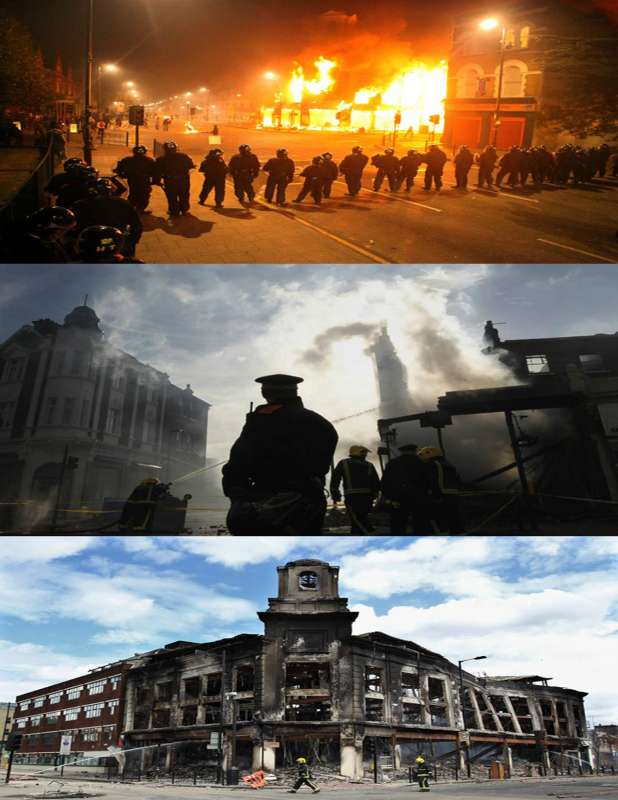LONDON—U.K. Home Secretary Theresa May has cut short her holiday to deal with the aftermath of a weekend of violent riots across London that saw cars and buildings burned and shops looted in some of the worst violence the country has seen in years.
The riots began on Saturday in Tottenham, north London, when a peaceful demonstration over the police shooting of a local man turned violent after bands of young men torched police cars, a double-decker bus and a number of buildings in the area.

On Sunday evening, groups of youths smashed windows and attacked cars in sporadic and more limited bouts of violence across mainly north London, the police said.
Police made a total of 161 arrests during a weekend of violence not seen since rioting the mid-1990s and a series of mainly race-related riots in the 1980s.
The police blamed a "criminal minority" for the trouble. "We believe that certain elements, who were not involved with the vigil, took the opportunity to commit disorder and physically attack police officers," said Commander Adrian Hanstock, from London's Metropolitan Police Service.
On Sunday, blackened shells of buildings were still smoldering. Destroyed cars and other debris littered the main street in Tottenham, an ethnically diverse, down-at-heel section of London with the capital's highest unemployment rate.
"It's devastating, just devastating," said David Lammy, the member of Parliament who represents Tottenham. "There is debris, burnt-out cars, the burnt-out buildings of ordinary shops, newsagents, hairdressers, run by ordinary people."
The British government condemned the violence. "There is no justification for the aggression the police and the public faced, or for the damage to property," a Downing Street spokesman said on Sunday.
Hundreds of residents turned out on Saturday afternoon to protest last week's death of Mark Duggan, a 29-year-old resident who was shot and killed by police's Operation Trident unit, which investigates gun crime in the black community. A police officer was also shot and injured in the incident. The demonstration outside the Tottenham police station proceeded peacefully for nearly three hours.
Shortly before 8:30 p.m., "a small minority" of protesters became violent, said a spokesman for the Metropolitan Police. They hurled gasoline-filled bottles at one police car and dragged another vehicle into the middle of the street, which had been closed to traffic to allow the demonstration. As the riots escalated, dozens of police on horseback and in riot gear were called in but struggled to contain the violence.
Television images from Saturday night showed hordes of young men, some wearing masks and handkerchiefs, smashing shop windows as fires raged in the streets and some buildings. Police said looters had ransacked shops and rioters were reported to have piled shopping carts with stolen goods.
The police spokesman said a "small number" of buildings, as well as two police cars and a bus, were set ablaze. Twenty-six police officers were injured, eight of whom were taken to hospitals. One officer sustained a head injury, the spokesman said. Three members of the public were treated for injuries. The London Fire Brigade said it dealt with 49 blazes.
The media criticized police for allowing the violence to escalate.
"There was no indication that the protest would deteriorate into the levels of criminal and violent disorder that we saw," said Commander Hanstock.
The police said they had extra patrols in the area on Sunday in case of further troubles. But trouble flared in other parts of London, including neighboring Edmonton and Walthamstow, and Brixton in south London, all relatively poor neighborhoods with large ethnic-minority communities.
Police on Sunday were still trying to identify people involved in the rioting. "We've recovered excellent CCTV footage," the police spokesman said, adding that more arrests are likely.
This year, a number of protests against public-spending cuts have turned violent, though none has matched the level of carnage seen over the weekend.
Tottenham in the past has been the scene of violent riots. In October 1985, violence erupted during a demonstration called to protest the death of a woman who had a heart attack after police burst into her home to execute a search. One police officer was hacked to death with a machete and dozens hospitalized. Mr. Lammy said the destruction this time was worse.
(Source)